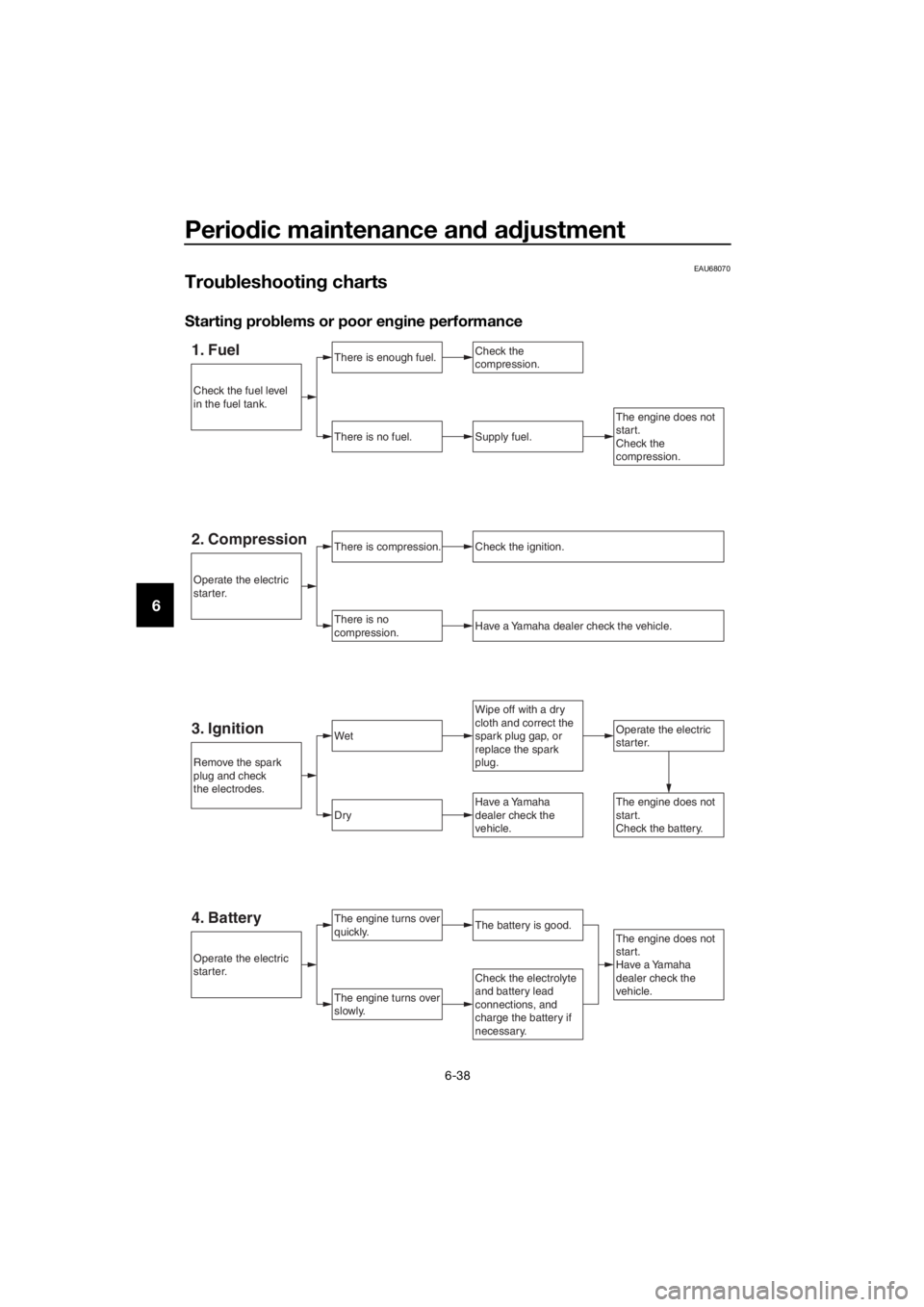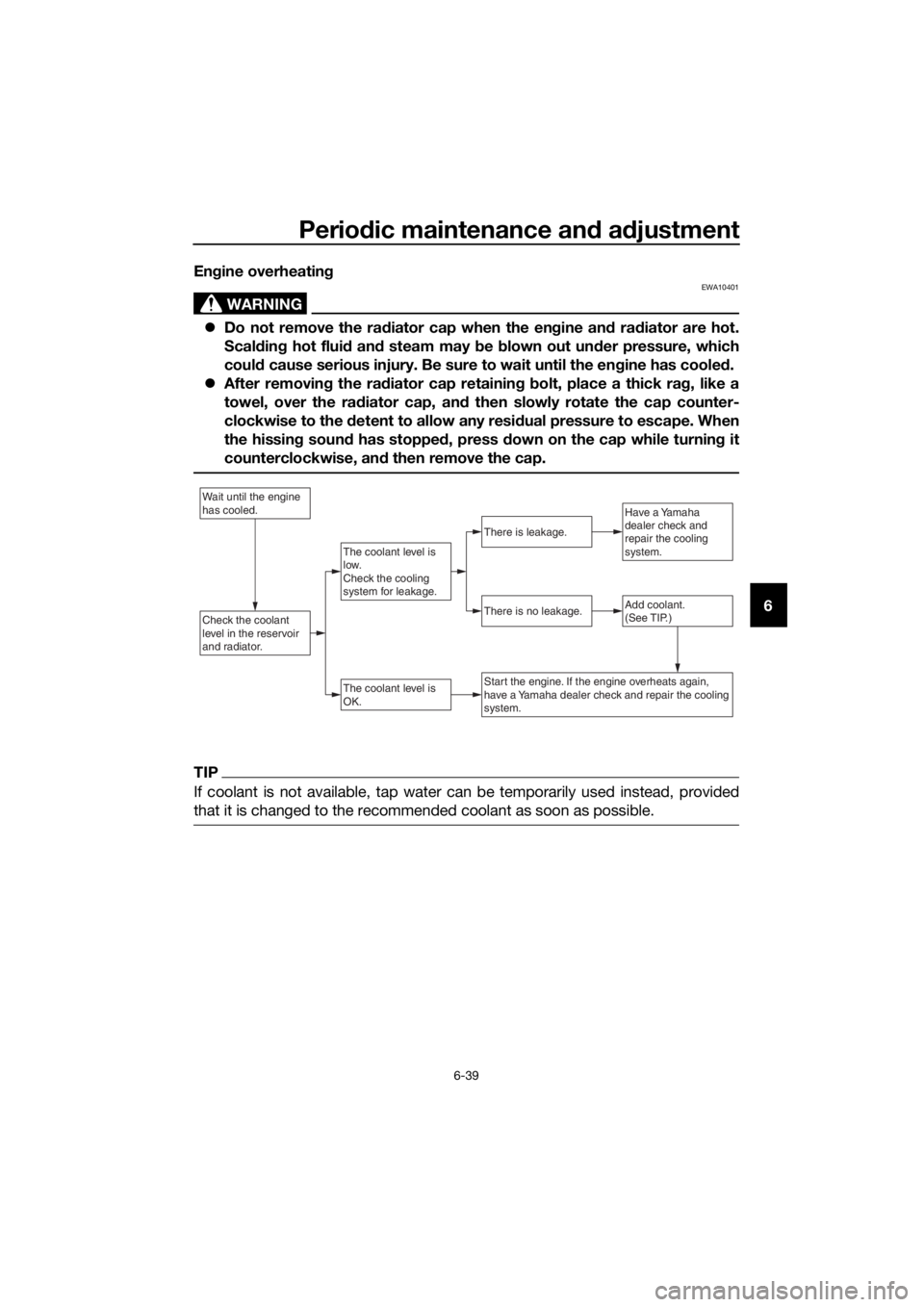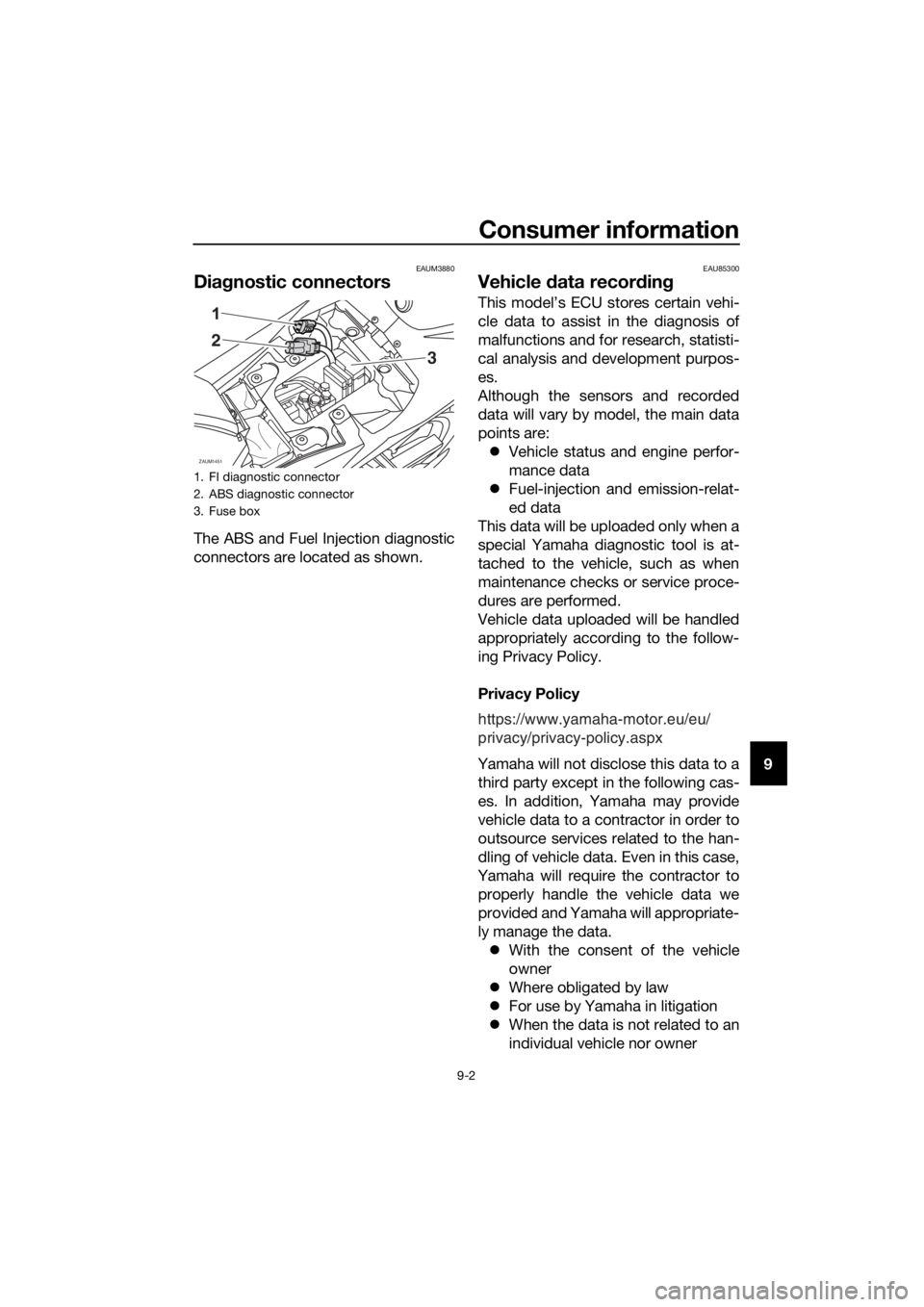check engine YAMAHA MT-125 2017 Owner's Manual
[x] Cancel search | Manufacturer: YAMAHA, Model Year: 2017, Model line: MT-125, Model: YAMAHA MT-125 2017Pages: 96, PDF Size: 7.1 MB
Page 58 of 96

Periodic maintenance and adjustment
6-16
6
EAU21402
Valve clearance
The valve clearance changes with use,
resulting in improper air-fuel mixture
and/or engine noise. To prevent this
from occurring, the valve clearance
must be adjusted by a Yamaha dealer
at the intervals specified in the periodic
maintenance and lubrication chart.
EAU59162
Tires
Tires are the only contact between the
vehicle and the road. Safety in all con-
ditions of riding depends on a relatively
small area of road contact. Therefore, it
is essential to maintain the tires in good
condition at all times and replace them
at the appropriate time with the speci-
fied tires.
Tire air pressure
The tire air pressure should be
checked and, if necessary, adjusted
before each ride.
WARNING
EWA10504
Operation of this vehicle with im-
proper tire pressure may cause se-
vere injury or death from loss of
control.
The tire air pressure must be
checked and adjusted on cold
tires (i.e., when the temperature
of the tires equals the ambient
temperature).
The tire air pressure must be
adjusted in accordance with the
riding speed and with the total
weight of rider, passenger, car-
go, and accessories approved
for this model.
UBR3E1E0.book Page 16 Wednesday, August 10, 2016 9:45 AM
Page 68 of 96

Periodic maintenance and adjustment
6-26
6
EAU23026
Cleaning and lubricating the
drive chain
The drive chain must be cleaned and
lubricated at the intervals specified in
the periodic maintenance and lubrica-
tion chart, otherwise it will quickly wear
out, especially when riding in dusty or
wet areas. Service the drive chain as
follows.
NOTICE
ECA10584
The drive chain must be lubricated
after washing the motorcycle, riding
in the rain or riding in wet areas.
1. Clean the drive chain with kero-
sene and a small soft brush.
NOTICE: To prevent damaging
the O-rings, do not clean the
drive chain with steam cleaners,
high-pressure washers or inap-
propriate solvents.
[ECA11122]
2. Wipe the drive chain dry.
3. Thoroughly lubricate the drive
chain with a special O-ring chain
lubricant. NOTICE: Do not use
engine oil or any other lubri-
cants for the drive chain, as they
may contain substances that
could damage the O-rings.
[ECA11112]EAU23098
Checking and lubricating the
cables
The operation of all control cables and
the condition of the cables should be
checked before each ride, and the ca-
bles and cable ends should be lubri-
cated if necessary. If a cable is
damaged or does not move smoothly,
have a Yamaha dealer check or re-
place it. WARNING! Damage to the
outer housing of cables may result
in internal rusting and cause inter-
ference with cable movement. Re-
place damaged cables as soon as
possible to prevent unsafe condi-
tions.
[EWA10712]
Recommended lubricant:
Yamaha cable lubricant or other
suitable cable lubricant
UBR3E1E0.book Page 26 Wednesday, August 10, 2016 9:45 AM
Page 80 of 96

Periodic maintenance and adjustment
6-38
6
EAU68070
Troubleshooting charts
Starting problems or poor engine performance
1. FuelThere is enough fuel.
There is no fuel.Supply fuel.
The engine turns over
quickly.
Operate the electric
starter.
Check the
compression.
The engine turns over
slowly.
Wipe off with a dry
cloth and correct the
spark plug gap, or
replace the spark
plug.
Check the electrolyte
and battery lead
connections, and
charge the battery if
necessary.
The engine does not
start.
Have a Yamaha
dealer check the
vehicle.
4. BatteryThe battery is good.
3. IgnitionWet
Dry
The engine does not
start.
Check the
compression.
Have a Yamaha
dealer check the
vehicle.The engine does not
start.
Check the battery.
Remove the spark
plug and check
the electrodes.
Check the fuel level
in the fuel tank.
Operate the electric
starter.
Operate the electric
starter.
There is compression.
There is no
compression.Have a Yamaha dealer check the vehicle.
Check the ignition.2. Compression
UBR3E1E0.book Page 38 Wednesday, August 10, 2016 9:45 AM
Page 81 of 96

Periodic maintenance and adjustment
6-39
6 Engine overheating
WARNING
EWA10401
Do not remove the radiator cap when the engine and radiator are hot.
Scalding hot fluid and steam may be blown out under pressure, which
could cause serious injury. Be sure to wait until the engine has cooled.
After removing the radiator cap retaining bolt, place a thick rag, like a
towel, over the radiator cap, and then slowly rotate the cap counter-
clockwise to the detent to allow any residual pressure to escape. When
the hissing sound has stopped, press down on the cap while turning it
counterclockwise, and then remove the cap.
TIP
If coolant is not available, tap water can be temporarily used instead, provided
that it is changed to the recommended coolant as soon as possible.
Wait until the engine
has cooled.
Check the coolant
level in the reservoir
and radiator.Add coolant.
(See TIP.)
The coolant level is
OK.
There is no leakage.
There is leakage.
The coolant level is
low.
Check the cooling
system for leakage.
Have a Yamaha
dealer check and
repair the cooling
system.
Start the engine. If the engine overheats again,
have a Yamaha dealer check and repair the cooling
system.
UBR3E1E0.book Page 39 Wednesday, August 10, 2016 9:45 AM
Page 85 of 96

Motorcycle care and storage
7-4
7
EAU43204
Storage
Short-term
Always store your motorcycle in a cool,
dry place and, if necessary, protect it
against dust with a porous cover. Be
sure the engine and the exhaust sys-
tem are cool before covering the mo-
torcycle.
NOTICE
ECA10811
Storing the motorcycle in a
poorly ventilated room or cover-
ing it with a tarp, while it is still
wet, will allow water and humid-
ity to seep in and cause rust.
To prevent corrosion, avoid
damp cellars, stables (because
of the presence of ammonia)
and areas where strong chemi-
cals are stored.
Long-term
Before storing your motorcycle for sev-
eral months:
1. Follow all the instructions in the
“Care” section of this chapter.
2. Fill up the fuel tank and add fuel
stabilizer (if available) to prevent
the fuel tank from rusting and the
fuel from deteriorating.
3. Perform the following steps to
protect the cylinder, piston rings,
etc. from corrosion.
a. Remove the spark plug cap
and spark plug.
b. Pour a teaspoonful of engine
oil into the spark plug bore.
c. Install the spark plug cap onto
the spark plug, and then place
the spark plug on the cylinderhead so that the electrodes are
grounded. (This will limit spark-
ing during the next step.)
d. Turn the engine over several
times with the starter. (This will
coat the cylinder wall with oil.)
WARNING! To prevent dam-
age or injury from sparking,
make sure to ground the
spark plug electrodes while
turning the engine over.
[EWA10952]
e. Remove the spark plug cap
from the spark plug, and then
install the spark plug and the
spark plug cap.
4. Lubricate all control cables and
the pivoting points of all levers and
pedals as well as of the side-
stand/centerstand.
5. Check and, if necessary, correct
the tire air pressure, and then lift
the motorcycle so that both of its
wheels are off the ground. Alterna-
tively, turn the wheels a little every
month in order to prevent the tires
from becoming degraded in one
spot.
6. Cover the muffler outlet with a
plastic bag to prevent moisture
from entering it.
7. Remove the battery and fully
charge it. Store it in a cool, dry
place and charge it once a month.
Do not store the battery in an ex-
cessively cold or warm place [less
than 0 °C (30 °F) or more than 30
°C (90 °F)]. For more information
on storing the battery, see page
6-31.
UBR3E1E0.book Page 4 Wednesday, August 10, 2016 9:45 AM
Page 91 of 96

Consumer information
9-2
9
EAUM3880
Diagnostic connectors
The ABS and Fuel Injection diagnostic
connectors are located as shown.
EAU85300
Vehicle data recording
This model’s ECU stores certain vehi-
cle data to assist in the diagnosis of
malfunctions and for research, statisti-
cal analysis and development purpos-
es.
Although the sensors and recorded
data will vary by model, the main data
points are: Vehicle status and engine perfor-
mance data
Fuel-injection and emission-relat-
ed data
This data will be uploaded only when a
special Yamaha diagnostic tool is at-
tached to the vehicle, such as when
maintenance checks or service proce-
dures are performed.
Vehicle data uploaded will be handled
appropriately according to the follow-
ing Privacy Policy.
Privacy Policy
Yamaha will not disclose this data to a third party except in the following cas-
es. In addition, Yamaha may provide
vehicle data to a contractor in order to
outsource services related to the han-
dling of vehicle data. Even in this case,
Yamaha will require the contractor to properly handle the vehicle data we
provided and Yamaha will appropriate-
ly manage the data. With the consent of the vehicle
owner
Where obligated by law
For use by Yamaha in litigation
When the data is not related to an
individual vehicle nor owner
1. FI diagnostic connector
2. ABS diagnostic connector
3. Fuse box
ZAUM1451
2
3
https://www.yamaha-motor.eu/eu/
privacy/privacy-policy.aspx
UBR3E2E0.book Page 2 Friday, May 11, 2018 11:09 AM
Page 92 of 96

10-1
10
Index
A
ABS ....................................................... 3-15
ABS warning light ................................... 3-3
Air filter element and check hose,
replacing and cleaning ....................... 6-14
Auxiliary lights ....................................... 6-35
B
Battery .................................................. 6-31
Brake and clutch levers, checking and
lubricating ........................................... 6-27
Brake fluid, changing ............................ 6-24
Brake fluid level, checking .................... 6-23
Brake lever ............................................ 3-14
Brake light switches.............................. 6-21
Brake pedal........................................... 3-15
Brake pedal, checking and
lubricating ........................................... 6-28
Brake pedal free play, adjusting ........... 6-21
C
Cables, checking and lubricating ......... 6-26
Care ........................................................ 7-1
Catalytic converter ................................ 3-18
Clutch lever ........................................... 3-13
Clutch lever free play, adjusting ........... 6-19
Coolant ................................................. 6-12
Cowlings, removing and installing .......... 6-7
D
Data recording, vehicle ........................... 9-2
Diagnostic connectors ............................ 9-2
Dimmer switch ...................................... 3-12
Drive chain, cleaning and lubricating .... 6-26
Drive chain slack................................... 6-24
E
Engine break-in....................................... 5-4
Engine idling speed, checking .............. 6-14
Engine oil and oil filter element ............... 6-9
Engine stop switch ............................... 3-12
Engine trouble warning light ................... 3-3
F
Front and rear brake pads, checking.... 6-22
Front brake lever free play, checking ... 6-20
Front fork, checking .............................. 6-29
Fuel ....................................................... 3-17
Fuel consumption, tips for reducing ....... 5-4
Fuel level warning light ........................... 3-2
Fuel tank cap ........................................ 3-16
Fuses, replacing.................................... 6-32
H
Handlebar switches .............................. 3-12
Headlight bulb, replacing ...................... 6-33High beam indicator light ....................... 3-2
Horn switch .......................................... 3-12
I
Identification numbers ............................ 9-1
Ignition circuit cut-off system............... 3-20
Indicator lights and warning lights ......... 3-2
Info switch ............................................ 3-12
L
License plate light bulb, replacing........ 6-36
M
Main switch/steering lock....................... 3-1
Maintenance and lubrication, periodic ... 6-4
Maintenance, emission control
system.................................................. 6-3
Matte color, caution ............................... 7-1
Model label ............................................. 9-1
Multi-function meter unit ........................ 3-4
N
Neutral indicator light ............................. 3-2
P
Parking ................................................... 5-5
Part locations ......................................... 2-1
Pass switch .......................................... 3-12
R
Rider seat ............................................. 3-19
S
Safety information .................................. 1-1
Shifting ................................................... 5-3
Shift pedal ............................................ 3-14
Sidestand ............................................. 3-20
Sidestand, checking and lubricating .... 6-28
Spark plug, checking ............................. 6-8
Specifications ......................................... 8-1
Starting the engine ................................. 5-2
Start switch .......................................... 3-12
Steering, checking................................ 6-30
Storage ................................................... 7-4
Supporting the motorcycle................... 6-37
Swingarm pivots, lubricating ................ 6-29
T
Tail/brake light ...................................... 6-35
Throttle grip and cable, checking and
lubricating .......................................... 6-27
Throttle grip free play, adjusting........... 6-15
Tires ...................................................... 6-16
Tool kit.................................................... 6-2
Troubleshooting ................................... 6-37
Troubleshooting charts ........................ 6-38
Turn signal indicator light ....................... 3-2
Turn signal light bulb, replacing ........... 6-36
UBR3E1E0.book Page 1 Wednesday, August 10, 2016 9:45 AM